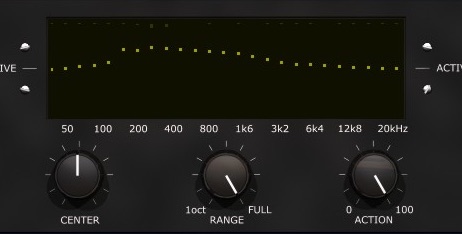(Written by Andrew J Klimek)
Concept
SoundBrigade uses non-linear phase IIR (infinite impulse response) filters (Quinto prefers their sound). The filters are arranged and programmed in such a way a lot of them are working even if you see action only in one narrow band.
SoundBrigade is powerful when you need a wide action (like on the whole spectrum), or automated (like when a resonance moves with played note, SoundBrigade continuously looks for the peak for you), and could sound a lot more transparent on some sources.
Settings
In general, you can simply think of a compressor. Threshold is threshold, Action is ratio (not wet/dry mix!), Control/Snap is the timing. The result is not the same (because this is not a compressor) but that’s a good reference to keep in mind.
Threshold – sets the internal level threshold for the filters. The actual value is related to Tilt control (see below).
Tilt – tilts the thresholds (is not a tilt EQ!). The pivot point is 50 Hz, where threshold isn’t affected by Tilt. For example, if Threshold is set to 0dB and Tilt is set to 6dB/octave, a filter centered at 100Hz (one octave about the reference, 50Hz) has a threshold of -6dB.
Makeup – a simple makeup gain after the effect.
Control/Snap switch – selects time constants for the effect. Control has fast attack, Snap has slower attack time so it could enhance transients. Think of the difference between a limiter and a 25ms attack compressor.
Center – set the center frequency for the range of action.
Range – set the width of the range of action. No effect is applied out of this range.
Action – scales the overall action of the effect, from dry to max sensitivity.
Missions
Tame – A track contains a frequency band which stands up too strong but an EQ isn’t the way to go. The action of the filters tames its level, while being transparent and preserving dynamics.
Control – Some tracks may require to get a fuller spectrum, not only by taming peaks but also by “upward” compressing components.
Wake-up – To be used on dull tracks, where dynamics are too compressed, or the spectrum is flat. Also interesting for experimenting. High peaks get higher, low valleys get lower.
Rotate – No EQ action, no modifications of the spectrum, just phase rotation. The more the filters are focused on a narrow range, the stronger their action. So called “dispersion” (makes “tac” sound “twack”), in a different way. Try it on strong peaks, as a de-esser, on pops and more. Note: Only Center and Range controls affect this Mission.
Master – Like Tame but filters’ parameters have a strong frequency dependence, suitable for a mix. Tame has constant parameters across the whole spectrum whereas Master has parameters related to frequency. In Master mode, attack and release are faster for higher frequencies. Only the release time is affected by Master mode when control/snap switch is set to “control” (because attack is always similar to limiter speeds with “control” set).
General Usage Suggestions
I generally put SoundBrigade before any corrective EQ (often instead of it) and compressor. The track becomes more regular and can be EQd and compressed with great control.
If it is on something that is being processed (not a raw track), I usually go back to try to fix it in the submix or pre-processing, then engage SoundBrigade again. I repeat it until SoundBrigade is just doing something dynamic and nothing static (dots moving and going back to zero instead of moving around a non-zero value. “Zero” position depends on the Mission).
I usually try to use it with centered center and full range, always starting with 100% action and reducing for best effect. If strength is not enough I focus the filters on a range (like in the example above).
It really helps compressors and limiters if put before them!
